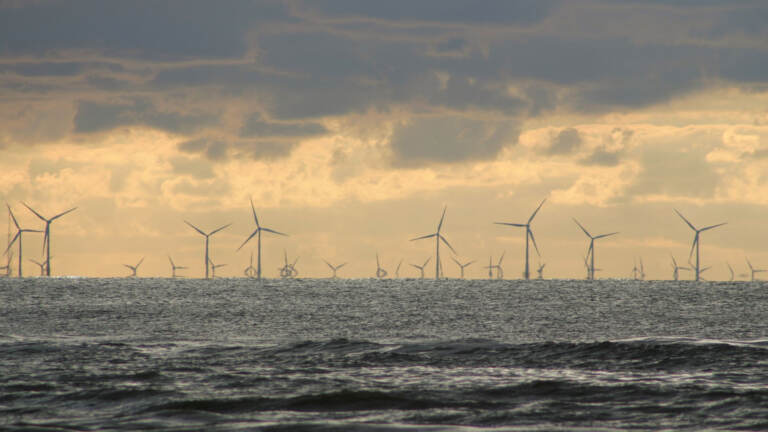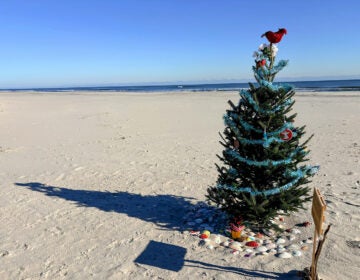Offshore wind farm builder tries to calm worries
Some residents fear turbines will damage tourism, but Ørsted says they will be barely visible.

Offshore wind farm (David Will/Pixabay)
This story originally appeared on NJ Spotlight.
The builder of New Jersey’s first planned offshore wind farm rejected renewed attacks by some Shore residents who fear that the sight of turbines on the horizon will keep tourists away, damage the coastal economy and erode property values.
Officials for the Ocean Wind 1 wind farm off Atlantic City and Ocean City said the turbines, due to be built between 15 and 27 miles offshore, will only be visible from the coastline on the clearest days, and that they have no evidence from overseas wind farms of any negative impact on tourism or property prices.
There is some evidence that wind farms actually stimulate tourism by people who want to see a forest of giant turbines up close, officials said. And the new turbines are expected to create reef-like conditions that will attract fish, offering new opportunities for recreational fishing.
“In all of our experience over the last thirty years, we have not seen a negative impact on tourism or property values in the communities that can see our wind farms,” said Maddy Urbish, head of government affairs and policy in New Jersey for Ørsted, the Danish offshore wind developer that owns 75% of the project. “Our evaluations show that visibility for the Ocean Wind project is going to be really limited, and only on the clearest day.”
The other 25% of the project is owned by the Newark-based energy company PSEG.
Staunch opponents
Urbish and eight other project officials spoke at an “open house” on Saturday to take questions from the public about the plan in Ocean City, where one of two electric lines from the new wind farm is due to bring power ashore, and where some residents and property owners remain staunchly opposed to the project despite the company’s assurances.
“Every single one of my renters who I’ve asked about this is horrified, and does not want to see this, and neither do I,” said Cathy Ingham, who has owned a rental house in Ocean City since 2004. “What’s going to happen to my property value? What’s going to happen to tourism?”
Richard Grist, real estate manager for the project, said that in Britain, which now has thousands of wind turbines offshore, there’s no evidence that they have impacted the value of coastal property, or deterred people from visiting coastal resorts. “There’s no impact on tourism that’s been seen in the UK,” he said.
To protect the tourist trade, construction won’t take place during the summer season, officials said. A power cable from the wind farm will be buried 50 feet below the dunes at Ocean City and laid 6 to 8 feet below the ocean floor before it comes ashore.
Officials also pledged to protect wildlife. Construction will halt if the North Atlantic right whale, a critically endangered species, is seen nearby, and surveys are being done on the migration path of the red knot, an imperiled shorebird, despite signs that most of the birds migrate closer to the shore than where the turbines will be built.
Light pollution?
Addressing opponents’ concerns that lighting for the wind farm will pollute the night sky, officials said required warning lights for aircraft will only come on if an aircraft enters a safety zone around the turbines. They estimated that would only happen for “a few hours a year.” Lighting for shipping is also required but that would only be visible for five nautical miles and so would not be visible from the shore.
Ocean Wind 1 is due to start commercial operations by the end of 2024. It will have up to 98 giant Haliade X wind turbines — the biggest in the world — whose blades will tower 853 feet above the ocean surface. Together, the turbines will generate 1,100 megawatts of emissions-free electricity, enough to power 500,000 homes.
If that results in an equivalent reduction in power generated from fossil-fuel sources like natural gas, it would mean 110 million tons less of CO2, about equal to that emitted from 20 million cars, escaping into the atmosphere over the anticipated 25-year life of the project, said Ørsted’s Pilar Patterson, the New Jersey permit manager for Ocean Wind, at Saturday’s event.
The project is being evaluated by the federal offshore wind regulator, the Bureau of Ocean Energy Management, which is expected to issue a draft environmental impact statement in May next year, and then its final approval in March 2023. At that point, construction would start.
The wind farm is due to be followed by two others: a second phase of Ocean Wind, generating the same amount of power as the first, and a separate project called Atlantic Shores which would build about 200 turbines 10-20 miles off the Shore between Atlantic City and Barnegat Light at the northern end of Long Beach Island.
Company considers compensation
Together, the three projects would generate 3,758 MW, or about half of Gov. Phil Murphy’s goal to obtain 7,500 MW from offshore wind by 2035. Murphy wants to achieve a 100% clean-energy economy by 2050, and 18% of the total would come from offshore wind, according to the Board of Public Utilities.
The cost of the project — which Ørsted says is “commercially sensitive and has not been disclosed” — will increase domestic electric bills by $1.46 a month for the average ratepayer statewide, although the actual amount per household will vary by consumption, Urbish said.
Craig Stewart, who lives in Ocean City year-round, asked company officials at the open house — which was attended by about 350 people in person and another 250 online — to describe the benefits of the project to residents like himself who oppose the project. Urbish said Ørsted is considering compensation that would recognize that the town is one of the points where the power from Ocean Wind will come ashore.
“As a proposed community that will be hosting the underground transmission to bring the electrons from the wind farm to the state, we would certainly want to work with the community and figure out what are the types of benefits that we could provide,” she said. “We haven’t had that level of discussion yet. It is absolutely something that is under consideration.”
Asked by Stewart why the wind farm couldn’t be sited further offshore, Urbish said the leased area was identified by the federal government, and its developers are not allowed to build outside it. “We have chosen to locate the turbines as far back as possible while meeting the goal of generating 1,100 megawatts,” she said.
Supporters too
The project received public support at the meeting from several local business leaders including Vicki Clark, president of the Cape May County Chamber of Commerce. She praised Ørsted for siting the wind farm 15 miles off the coast but asked for an assurance that the next phase of the project will be just as far away, to protect the county’s $6.9 billion tourism industry.
“I would like to thank you that the turbines are fifteen miles off our coast,” she said. “They will be very difficult to see with the naked eye.”
But she urged the company and federal regulators to communicate better with the local fishing industry whose concerns about the wind farm she said are not being addressed.
Former Gov. Jim Florio added his voice in support at the meeting, saying that his credentials for attending were owning a house at Sea Isle City and having traveled to Denmark to visit offshore wind farms there. He said the emissions-free power from the wind farm will help protect the Jersey Shore from the bigger storms, higher seas and increased flooding that are coming with climate change. “There is no force more powerful than an idea whose time has come,” he said.
Jody Stewart said she has lived at the Shore for 40 years “so my heart does belong here.” She moved out of one town to escape flooding, only to find that her new community now floods too, and sees the offshore wind industry as a down payment on a safer future. “It’s scary as hell,” she said. “I’m thrilled with the turbines coming. It’s time for us to move into the future.”

Get daily updates from WHYY News!
WHYY is your source for fact-based, in-depth journalism and information. As a nonprofit organization, we rely on financial support from readers like you. Please give today.






